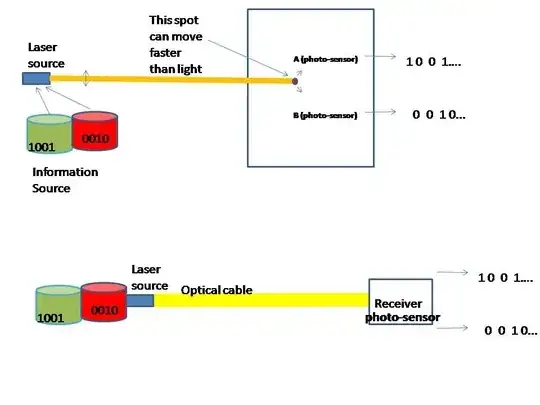First statement of this question: In superluminal phase velocities, what is it that is traveling faster than light? says that
information cannot be transmitted at a velocity greater than speed of light
Also in the comment to my recent question: Is parallel programming a need of future and worth investing time and money? it is said that:
FTL communication between the two ends of our processors is impossible.
Now I have conceptual model of communication system as shown below:

In the upper model, a laser is being moved up and down, and is being detected by the photo-detectors A & B. If the laser spot is at A , A's output is 1 else 0, and similarly for B.
In the lower model, a simple optical fiber based communication is being shown.
In both the cases we are transmitting data (1001 & 0010) from two sources Green and Red.
Now if we assume that the distance between laser and photo sensors A & B is very large, it can be proved that the spot (shown in red) can move at speed greater than light.
Can somebody explain this fallacy? In my first case information is being conveyed at a speed which is more than the speed of light, and is thus faster way of transmitting information as compared to fiber shown in the lower diagram. How is this possible?
Why information is being conveyed at much faster rate in upper case? Start from the case when the laser beam is in between the two detectors. Now let us transfer a 1 to A. So I need to move my hand up - let us say I do this at a speed of 1cm/s. Let us say with this velocity, in 1 second the spot reaches the detector A. So I have conveyed the information '1' in 1 second. And this comm took at a speed of spot which s greater that that of light. Now consider the case of usual optical comm. Assume that the distance is sufficiently large, so that light takes more than 1 second to reach the receiver.
What is wrong in my calculations?
Also Even If I do not compare upper and lower case, am I not proving that information is being conveyed at speed more than that of light. this is because the information is carried in spot that is capable of moving at a speed greater than C.